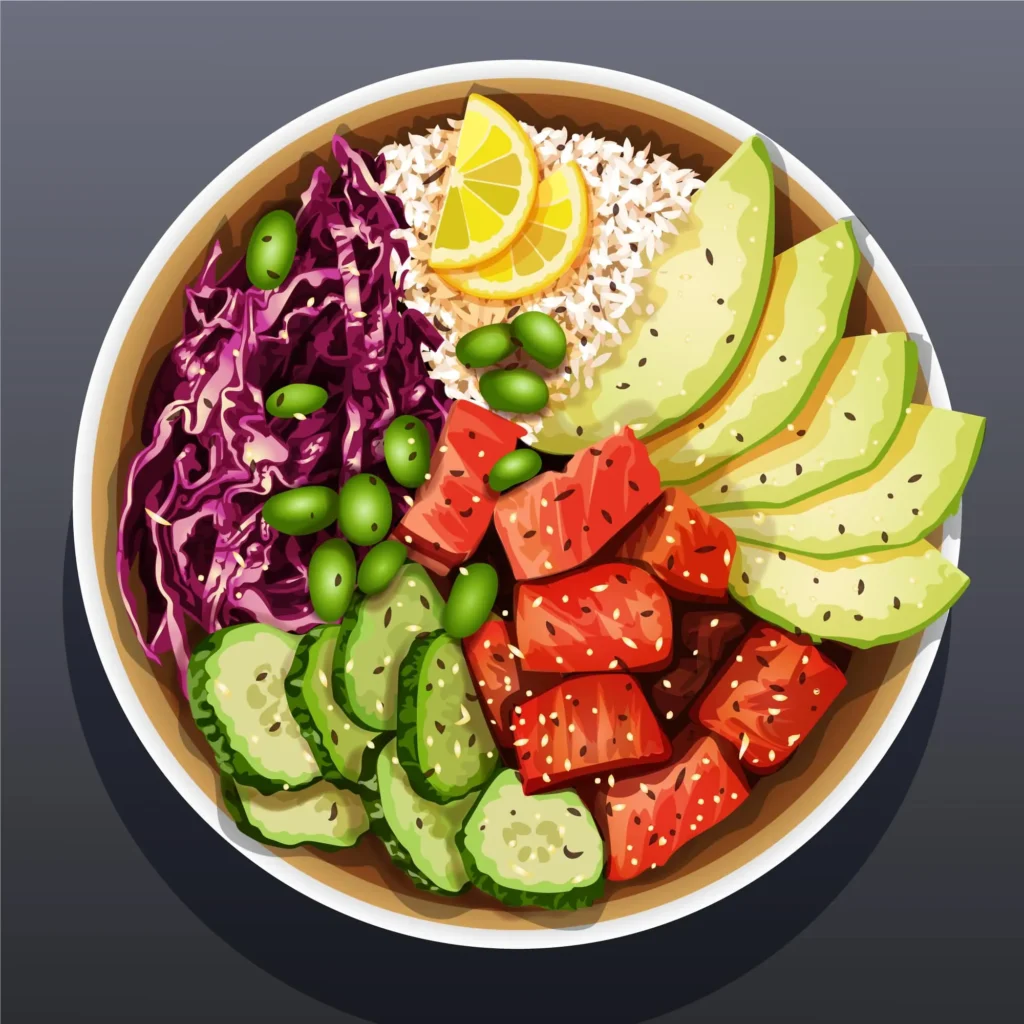Introduction:
Salads have long been hailed as a healthy choice for those looking to maintain a balanced diet or shed a few pounds. Packed with an array of colorful vegetables, fruits, proteins, and grains, salads offer a nutritious and satisfying meal option. However, one common question that often arises is, How many calories are in salad? In this article, we delve into the caloric content of salads, exploring various ingredients and their impact on calorie count, as well as offering tips for making healthier salad choices. Discover the calories in chicken salad! Enjoy a healthy, balanced meal by knowing the nutritional value of your favorite dish.
Basics of Salad Composition
The basics of salad composition encompass a variety of components that come together to create a satisfying and nutritious dish. At its core, a salad typically starts with a base of leafy greens, such as lettuce, spinach, or arugula, which provide a foundation of vitamins, minerals, and fiber. These greens serve as a vehicle for other ingredients, adding bulk and volume to the salad.
In addition to leafy greens, salads often incorporate a diverse array of vegetables, ranging from crisp cucumbers and juicy tomatoes to crunchy bell peppers and shredded carrots. These vegetables not only contribute vibrant colors and flavors but also provide essential nutrients like vitamins A and C, as well as antioxidants.
Low-calorie Salads
Leafy greens serve as the nutritional powerhouse and low-calorie base for many salads. When considering How many calories are in salad? these greens play a significant role in keeping the count low. Typically, leafy greens like spinach, kale, and romaine lettuce are incredibly low in calories, making them ideal choices for those watching their calorie intake. For instance, a cup of raw spinach contains just 7 calories, while a cup of shredded romaine lettuce has only 8 calories. Incorporating a generous portion of leafy greens into your salad provides essential vitamins, minerals, and fiber without significantly impacting calorie consumption.
| Ingredient | Approximate Calories per Serving |
| Leafy Greens (e.g., lettuce, spinach, arugula) | 5-10 calories |
| Cucumbers | 8 calories (per half cup sliced) |
| Tomatoes | 18 calories (per medium tomato) |
| Bell Peppers | 24 calories (per medium pepper) |
| Celery | 6 calories (per stalk) |
| Radishes | 9 calories (per half cup sliced) |
| Carrots | 25 calories (per medium carrot) |
| Onions | 10 calories (per half cup chopped) |
Common Salad Ingredients’ Calories:
1: Leafy greens
- Low in calories: typically around 5-10 calories per cup
- High in vitamins A, C, and K, as well as fiber
2: Vegetables
- Varies in caloric content depending on the vegetable
- Generally low in calories: for example, a medium tomato has about 25 calories
- Rich in vitamins, minerals, and antioxidants
3: Proteins
- Caloric content varies depending on the protein source and portion size
- Lean proteins like grilled chicken and tofu are lower in calories compared to fatty meats
- Protein helps promote satiety and supports muscle growth and repair
4: Cheese
- High in calories and fat: for example, one ounce of cheddar cheese contains around 110 calories
- Provides protein and calcium but should be used sparingly due to its calorie density
5: Nuts and seeds
- Caloric content varies by type: for example, almonds have around 160 calories per ounce
- Rich in healthy fats, protein, and fiber
- Adds crunch and flavor to salads but should be portion-controlled due to calorie density
Impact of Portion Size
The impact of portion size on the calorie content of a salad, and consequently on the answer to the question How many calories are in salad?, cannot be overstated. Portion size plays a pivotal role in determining the overall caloric intake of any meal, including salads. Whether it’s a generous portion brimming with nutritious ingredients or a more modest serving intended to complement a main dish, the size of the portion directly influences the number of calories in chicken salad consumed.
Consider a salad adorned with leafy greens, vibrant vegetables, and a protein source. While each ingredient may be relatively low in calories, the cumulative effect of larger portion sizes can lead to a significant increase in caloric intake. Conversely, opting for smaller portions can help manage calorie consumption without sacrificing satiety or nutritional value.
Role of Dressings

The role of dressings in salads is pivotal, not only for enhancing flavor but also for contributing to the overall calorie count. When considering How Many Calories Are in Salad?, dressings can significantly influence the answer. While dressings add richness and moisture to salads, they often contain oils, fats, and other calorie-dense ingredients that can substantially increase the caloric content of a meal.
Creamy dressings like ranch, Caesar, or blue cheese tend to be higher in calories due to their base of mayonnaise, sour cream, or cheese. Just a few tablespoons of these dressings can add hundreds of calories in chicken salad to an otherwise healthy salad.
Balancing Macronutrients
- Adjust ratios based on goals, like weight loss, muscle gain, or performance
- Prioritize nutrient-dense sources for optimal health
- Monitor portion sizes to prevent overconsumption
- Pay attention to meal timing for energy levels
- Experiment with meal compositions to find what suits you
- Consult a dietitian for personalized guidance
- Ensure meals contain appropriate proportions of carbohydrates, proteins, and fats
- Carbohydrates provide energy and come from whole grains, fruits, vegetables, and legumes
Incorporating Fiber-rich Ingredients
Incorporating fiber-rich ingredients into your salads not only enhances their nutritional value but also influences the answer to How Many Calories Are in Salad? Fiber-rich foods contribute to satiety, aid digestion, and support overall health by regulating blood sugar levels and promoting a healthy gut. By including fiber-rich ingredients, such as leafy greens, vegetables like broccoli and Brussels sprouts, beans, lentils, and whole grains like quinoa or barley, you can increase the volume of your salad without significantly increasing its calorie content.
These ingredients add bulk and texture to salads, helping you feel fuller for longer while providing essential nutrients. Additionally, fiber-rich foods often have fewer calories per gram compared to their processed counterparts, making them ideal choices for those watching their calorie intake.
Customizing Salads for Dietary Preferences

- Consider dietary preferences: vegetarian, vegan, gluten-free, or keto
- Incorporate plant-based proteins for vegetarians and vegans
- Choose dairy-free options for lactose intolerance or vegan diets
- Avoid gluten-containing ingredients for gluten-free salads
- Opt for gluten-free grains like quinoa or rice
- Focus on low-carb vegetables for keto-friendly salads
- Include high-fat ingredients for keto satiety
- Customize salads for nut-free or soy-free preferences
- Offer a variety of toppings and dressings for customization
Strategies for Reducing Salad Calories
Strategies for reducing salad calories are essential for individuals seeking to manage their weight or maintain a calorie-conscious diet. When considering How Many Calories Are in Salad? implementing certain strategies can help lower the calorie content without sacrificing taste or satisfaction. One effective approach is to opt for lighter dressing options such as vinegar-based dressings or lemon juice, which provide flavor without adding excess calories from oils or creamy bases. Additionally, controlling portion sizes of calorie-dense ingredients like cheese, nuts, seeds, and croutons can significantly reduce the overall calorie count of the salad.
Choosing lean protein sources such as grilled chicken or tofu instead of higher-fat options can also contribute to calorie reduction while still providing essential nutrients. Incorporating a variety of colorful, non-starchy vegetables as the base of the salad can increase volume and fiber content without substantially increasing calories. Moreover, experimenting with herbs, spices, and flavorful ingredients like citrus fruits or roasted vegetables can enhance taste without additional calories. By implementing these strategies, individuals can enjoy delicious and satisfying salads while managing their calorie intake effectively.
Conclusion:
In conclusion, the number of calories in chicken salad can vary widely depending on its ingredients and preparation methods. By understanding the calorie content of different salad components and making mindful choices, you can enjoy delicious and nutritious salads that align with your health and dietary goals.
Frequently Asked Questions:
Q1: Are salads always low in calories?
Not necessarily. While salads can be low in calories, the calorie content can vary greatly depending on the ingredients and portion sizes. Salads with high-calorie toppings like cheese, nuts, seeds, croutons, and creamy dressings can be calorie-dense.
Q2: How can I make a salad more filling without adding excess calories?
To make a salad more filling without adding excess calories, focus on incorporating high-fiber ingredients like leafy greens, vegetables, beans, and whole grains. These ingredients add bulk and satiety without significantly increasing calorie intake.
Q3: Are all salad dressings high in calories?
No, not all salad dressings are high in calories. While creamy dressings like ranch or blue cheese tend to be higher in calories due to their fat content, vinegar-based dressings or simple oil and vinegar combinations can be lower in calories.
Q4: Can I lose weight by eating salads every day?
Eating salads every day can be a healthy component of a weight loss plan, but it ultimately depends on the overall calorie balance and variety of ingredients in the salads. To lose weight, it’s important to consume salads that are balanced in nutrients and portion sizes while also incorporating other healthy foods and exercising regularly.
Q5: What are some healthy protein options for salads?
Healthy protein options for salads include grilled chicken breast, tofu, tempeh, hard-boiled eggs, beans, lentils, chickpeas, and seafood like shrimp or salmon. These protein sources add satiety and essential nutrients to salads.
If you find this article interesting and helpful, then visit our site FuseBay for more articles like this.








